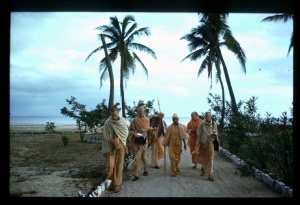SB 5.21.11: Difference between revisions
m (1 revision(s)) |
No edit summary |
||
| Line 1: | Line 1: | ||
{{info | {{info | ||
|speaker= | |speaker=Śukadeva Gosvāmī | ||
|listener=King | |listener=King Parīkṣit | ||
}} | }} | ||
[[Category:Srimad-Bhagavatam - Canto 05 Chapter 21]] | |||
[[Category:Bhagavatam Verses Spoken by Sukadeva Gosvami - Vanisource|052111]] | |||
<div style="float:left">'''[[Srimad-Bhagavatam]] - [[SB 5|Fifth Canto]] - [[SB 5.21: The Movements of the Sun|Chapter 21: The Movements of the Sun]]'''</div> | |||
<div style="float:right">[[File:Go-previous.png|link=SB 5.21.10]] '''[[SB 5.21.10]] - [[SB 5.21.12]]''' [[File:Go-next.png|link=SB 5.21.12]]</div> | |||
{{RandomImage}} | |||
==== TEXT 11 ==== | ==== TEXT 11 ==== | ||
<div | <div class="verse"> | ||
evaṁ tato vāruṇīṁ saumyām aindrīṁ ca punas tathānye ca grahāḥ somādayo nakṣatraiḥ saha jyotiś-cakre samabhyudyanti saha vā nimlo-canti | :evaṁ tato vāruṇīṁ saumyām aindrīṁ ca | ||
:punas tathānye ca grahāḥ somādayo nakṣatraiḥ | |||
:saha jyotiś-cakre samabhyudyanti saha vā nimlo-canti | |||
</div> | </div> | ||
| Line 13: | Line 21: | ||
==== SYNONYMS ==== | ==== SYNONYMS ==== | ||
<div | <div class="synonyms"> | ||
''evam''—in this way; ''tataḥ''—from there; ''vāruṇīm''—to the quarters where Varuṇa lives; ''saumyām''—to the quarters where the moon lives; ''aindrīṁ ca''—and to the quarters where Indra lives; ''punaḥ''—again; ''tathā''—so also; ''anye''—the others; ''ca''—also; ''grahāḥ''—planets; ''soma-ādayaḥ''—headed by the moon; ''nakṣatraiḥ''—all the stars; ''saha''—with; ''jyotiḥ-cakre''—in the celestial sphere; ''samabhyudyanti''—rise; ''saha''—along with; ''vā''—or; ''nimlocanti''—set. | |||
</div> | </div> | ||
| Line 20: | Line 28: | ||
==== TRANSLATION ==== | ==== TRANSLATION ==== | ||
<div | <div class="translation"> | ||
From the residence of Yamarāja the sun travels to Nimlocanī, the residence of Varuṇa, from there to Vibhāvarī, the residence of the moon-god, and from there again to the residence of Indra. In a similar way, the moon, along with the other stars and planets, becomes visible in the celestial sphere and then sets and again becomes invisible. | From the residence of Yamarāja the sun travels to Nimlocanī, the residence of Varuṇa, from there to Vibhāvarī, the residence of the moon-god, and from there again to the residence of Indra. In a similar way, the moon, along with the other stars and planets, becomes visible in the celestial sphere and then sets and again becomes invisible. | ||
</div> | </div> | ||
| Line 27: | Line 35: | ||
==== PURPORT ==== | ==== PURPORT ==== | ||
<div | <div class="purport"> | ||
In Bhagavad-gītā ([[BG 10.21]]) Kṛṣṇa says, nakṣatrāṇām ahaṁ śaśī: "Of stars I am the moon." This indicates that the moon is similar to the other stars. The Vedic literature informs us that within this universe there is one sun, which is moving. The Western theory that all the luminaries in the sky are different suns is not confirmed in the Vedic literature. Nor can we assume that these luminaries are the suns of other universes, for each universe is covered by various layers of material elements, and therefore although the universes are clustered together, we cannot see from one universe to another. In other words, whatever we see is within this one universe. In each universe there is one Lord Brahmā, and there are other demigods on other planets, but there is only one sun. | In ''Bhagavad-gītā'' ([[BG 10.21 (1972)|BG 10.21]]) Kṛṣṇa says, ''nakṣatrāṇām ahaṁ śaśī:'' "Of stars I am the moon." This indicates that the moon is similar to the other stars. The Vedic literature informs us that within this universe there is one sun, which is moving. The Western theory that all the luminaries in the sky are different suns is not confirmed in the Vedic literature. Nor can we assume that these luminaries are the suns of other universes, for each universe is covered by various layers of material elements, and therefore although the universes are clustered together, we cannot see from one universe to another. In other words, whatever we see is within this one universe. In each universe there is one Lord Brahmā, and there are other demigods on other planets, but there is only one sun. | ||
</div> | </div> | ||
__NOTOC__ | |||
<div style="float:right; clear:both;">[[File:Go-previous.png|link=SB 5.21.10]] '''[[SB 5.21.10]] - [[SB 5.21.12]]''' [[File:Go-next.png|link=SB 5.21.12]]</div> | |||
__NOTOC__ | |||
__NOEDITSECTION__ | |||
Revision as of 09:54, 1 June 2021

A.C. Bhaktivedanta Swami Prabhupada
TEXT 11
- evaṁ tato vāruṇīṁ saumyām aindrīṁ ca
- punas tathānye ca grahāḥ somādayo nakṣatraiḥ
- saha jyotiś-cakre samabhyudyanti saha vā nimlo-canti
SYNONYMS
evam—in this way; tataḥ—from there; vāruṇīm—to the quarters where Varuṇa lives; saumyām—to the quarters where the moon lives; aindrīṁ ca—and to the quarters where Indra lives; punaḥ—again; tathā—so also; anye—the others; ca—also; grahāḥ—planets; soma-ādayaḥ—headed by the moon; nakṣatraiḥ—all the stars; saha—with; jyotiḥ-cakre—in the celestial sphere; samabhyudyanti—rise; saha—along with; vā—or; nimlocanti—set.
TRANSLATION
From the residence of Yamarāja the sun travels to Nimlocanī, the residence of Varuṇa, from there to Vibhāvarī, the residence of the moon-god, and from there again to the residence of Indra. In a similar way, the moon, along with the other stars and planets, becomes visible in the celestial sphere and then sets and again becomes invisible.
PURPORT
In Bhagavad-gītā (BG 10.21) Kṛṣṇa says, nakṣatrāṇām ahaṁ śaśī: "Of stars I am the moon." This indicates that the moon is similar to the other stars. The Vedic literature informs us that within this universe there is one sun, which is moving. The Western theory that all the luminaries in the sky are different suns is not confirmed in the Vedic literature. Nor can we assume that these luminaries are the suns of other universes, for each universe is covered by various layers of material elements, and therefore although the universes are clustered together, we cannot see from one universe to another. In other words, whatever we see is within this one universe. In each universe there is one Lord Brahmā, and there are other demigods on other planets, but there is only one sun.